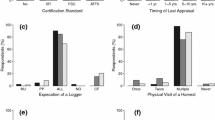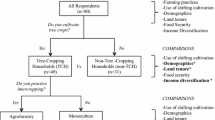Abstract
A mail survey was conducted to gain understanding of the agroforestry practices of non-industrial private forest landowners (NIPF) in Washington State, located in the north-western USA. Although NIPF owners control 1.5 million hectares of the state's commercial forestland base, their diversity of forestland uses, land management practices and objectives as land managers are not well understood. Past NIPF surveys and anecdotal information suggest agroforestry is a major use of NIPF lands. We defined agroforestry as a potentially sustainable land use practice combining the deliberate growing of woody perennials with agricultural crops and/or animals.
Objectives of this study were to:
-
1)
determine the extent that agroforestry is used by Washington's NIPF owners,
-
2)
develop insight into NIPF owners' motivations for practicing agroforestry,
-
3)
describe the agroforestry practices within three distinct physiographic and agroecological zones in Washington, and
-
4)
determine the agroforestry information needs of NIPF owners.
The target population consisted of NIPF owners in 4 counties within each of the three regions. Response to the August 1990 mail survey was 63.5%, yielding 296 useable questionnaires. Fifty-seven percent of all respondents practice agroforestry. Forestland grazing is the most common agroforestry practice (39% of all respondents), followed by windbreaks (34%), harvest of special forest products (12%), livestock enrichment plantings for forage or shelter (7%), orchard grazing (5%), orchard intercropping (2%), and Christmas tree grazing (0.34%).
The most frequent motives for owning land were passing land on to children (80%), keeping it natural and income from timber (both 72%). Respondents saw aesthetics (77%), increasing land unit income (74%), and water conservation (70%) as possible advantages of practicing agroforestry. High establishment costs (66%) and livestock damage to trees or crops (64%) were the most frequently selected potential disadvantages to practicing agroforestry. Lack of technical and educational support (67%) and lack of access to livestock/livestock facilities (58%) were disincentives to practicing agroforestry. Landowners are interested in learning more about agroforestry and how agroforestry techniques might be incorporated in their land management tool kit. A significant number of non-industrial private forest land owners in Washington believe that management of forestland, balancing conservation and production goals, can be furthered by suitable agroforestry practices.
Similar content being viewed by others
References
Baumgartner DM (1980) Nonindustrial private forestland owners: Stevens County, Washington. In: Proceedings of the 1979 convention of the Society of American Foresters, pp 266–268. Society of American Foresters, Bethesda, Maryland, USA
Blatner KA, Baumgartner DM and Quackenbush LR (1991) NIPF use of landowner assistance and education programs in Washington State. Western Journal of Applied Forestry 6(4): 90–94
Bliss JC and Martin AJ (1989) Identifying NIPF management motivations with qualitative methods. Forest Science 35: 601–622
Brandle JR, Hintz DL and Sturrock JW, ed, (1988) Windbreak technology: Proceedings of an international symposium on windbreak technology. Lincoln, Nebraska June 23–27 1986. Elsevier Science Publishers, Amsterdam
Clothier GL (1914) Forest windbreaks as a protection to the light soils of the Columbia River Basin. Department of Extension Series 1 No. 4, State College of Washington, Pullman, Washington, USA
Dickson A (1985) What owners expect from their woodlots. The Forestry Chronicle 4: 159–162
Dillman DA (1979) Mail and Telephone Surveys: The Total Design Method. John Wiley & Sons, New York, USA
Force JE and Lee HW (1991) Nonindustrial private forest owners in Idaho. Western Journal of Applied Forestry 6(3): 32–36
Franklin JF and Dyrness CT (1973) Natural vegetation of Oregon and Washington. Forest Service General Technical Report, PNW-8, US Department of Agriculture
Gordon AM and Williams PA (1990) Agroforestry research and development: 1989–1990, Annual Report to the Ontario Ministry of Agriculture and Food. Department of Environmental Biology, University of Guelph, Guelph, Ontario, Canada
Hanley D (1984) Trees against the wind. PNW 5 Pacific Northwest extension publication, US Forest Service, Moscow, Idaho, USA
Harris GA and Chaney M (1984) Washington State grazing land assessment. Washington State University Cooperative Extension, Pullman, Washington, USA.
Lawrence JH and LH Hardesty (1992) Mapping the territory: a survey to evaluate agroforestry awareness among Washington State land managers. Agroforestry Systems (In press)
Lawrence JH et al. (1992) Forest grazing practices of Washington non-industrial forest private forest landowners (Submitted to Journal of Range Management)
Microsoft (1989) Microsoft: Excel 2.2. Microsoft, Seattle, Washington, USA
Minitab (1988) MINITAB: Statistical software (5.1). Minitab, Inc., State College, Pennsylvania, USA
Nagle JP and Steffen EH (1940) Trees for Washington farms. Popular Bulletin No. 159 State College of Washington, Agricultural Experiment Station, Pullman, Washington, USA
Nair PKR (1985) Classification of agroforestry systems. Agroforestry Systems 3: 97–128
Schlosser WE, Blatner KA and Chapman RC (1991) Economic and marketing implications of special forest products harvest in the coastal Pacific Northwest. Western Journal of Applied forestry 6: 67–70
Weatherhead DJ, Chapman RC and Kelso WH (1982) Characteristics of NIPF landowners of Spokane County, Washington. Research Bulletin. XB 0928, Agricultural Research Center, Washington State University, Pullman, Washington, USA
West AJ (1988) Conservation reserve tree planting: Can we improve upon success? Journal of Soil and Water Conservation 43: 66–67
Wetton CE (1988) A survey of private forest land owners in British Columbia FRDA Report 044 Forest Resource Development Agreement, Victoria, British Columbia, Canada
Wilkinson L (1989) SYSTAT: The system of statistics. SYSTAT Inc., Evanston, Illinois, USA
Author information
Authors and Affiliations
Rights and permissions
About this article
Cite this article
Lawrence, J.H., Hardesty, L.H., Chapman, R.C. et al. Agroforestry practices of non-industrial private forest landowners in Washington State. Agroforest Syst 19, 37–55 (1992). https://doi.org/10.1007/BF00130093
Issue Date:
DOI: https://doi.org/10.1007/BF00130093




